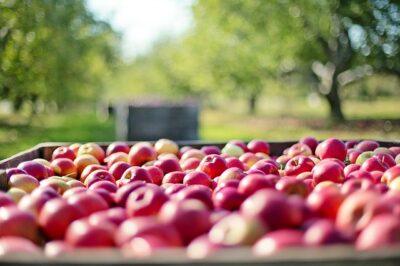 I have 80 acres of property in Michigan. It’s been in the family for five generations, and 30 years ago I was smart enough to plant a variety of fruit trees.
I have 80 acres of property in Michigan. It’s been in the family for five generations, and 30 years ago I was smart enough to plant a variety of fruit trees.
I planted sweet cherry trees for snacking and sour cherry trees for baking. I have continually lost the sweet cherry war with the birds. The sour cherries have done fine if you don’t mind pitting a bushel of sour cherries on a long weekend.
The pears and peaches have done well, and we “can” with them or bake with them. We also set them on the table for snacking, but we end up giving many of them away simply because we don’t have the time to process the entire harvest.
However, it’s all very different when it comes to the apple trees. We’ll easily get four bushels or more from each of our 10 trees for a total of 40-plus bushels — and we use every one of them. Over the years we keep finding new uses for apples, and I think it’s the most versatile fruit I’ve come across.
The ‘Fruit Gardener’s Bible’: Your Complete Resource To Growing Fruits And Nuts!
Here are the top seven things we’ve learned to make with our apple harvest:
1. Apple cider
We pick up windfall apples off the ground. They’re a bit gnarly and often bruised, but we don’t care. We gather them, rinse them, grind them up in the apple grinder and toss the mash into the apple press to make apple cider. This kind of cider has to be refrigerated in some way. You could also process it with a heat process like you would use for traditional canning. The good news is that this usually takes place in autumn, and the overnight temps help with off-the-grid refrigeration.
2. Apple cider vinegar
Apple cider vinegar is a natural disinfectant and cleaner and is a foundation for many food preservation solutions. It is reported to have significant health benefits, and its versatility crosses from marinades to salad dressings to brines and cures. Apple cider vinegar may be the most significant benefit of the apple tree.
3. Apple sauce
It’s so easy to make. Peel and core apples, and chop. Add to a sauce pan with some apple cider and a little sugar and cinnamon. Gently simmer, and either mash or leave in chunks. It is wonderful as an accompaniment to pork. Refrigerate or process with standard canning procedures.
4. Apple butter
Apple butter is apple sauce on steroids. This recipe is for a crockpot, and it takes 10 hours on low. Peel, core and finely chop six pounds of apples and toss into the crockpot with four cups of sugar, two teaspoons of cinnamon, one-fourth teaspoon of salt, one-fourth teaspoon of ground cloves and stir until blended. Set crockpot on low, and stir occasionally for about 10 hours. Serve, refrigerate or process.
5. Baked apples
We’ll gather a bunch of apples, and either wrap them in foil over the grill or bake them in the oven. We keep the skins on and core the apples, being careful to not cut down to the base. (You want a little pocket in the core of the apple). The standard ingredient is a tablespoon of butter in the core with a mix of brown sugar and spices.
Need Non-GMO Heirloom Seeds For Your Spring Garden? The Best Deals Are Right Here!
I usually blend one-half teaspoon of cinnamon, one-fourth teaspoon of nutmeg and one-fourth teaspoon of cloves with about two tablespoons of brown sugar for each apple. I dump all of that in the core of the apple and wrap in foil over indirect heat on the grill, or bake in the oven on a cookie sheet. I give them both about an hour no matter how I’m cooking them. Let them rest a bit or you’ll burn your mouth.
6. Apple pie
There’s a filling for apple pie that can be used across purposes, from a spooned pie-filling on a plate to a filling for an apple pie. The basic filling consists of peeled, cored and sliced apples tossed in a tablespoon of apple cider vinegar with a cup of sugar, two teaspoons of cinnamon, two tablespoons of corn starch or flour, and a tablespoon of salt all tossed together and dumped in the pie shell. Bake at 350 (Fahrenheit) for an hour.
7. Dried apples
There are a lot of ways to make this, but the simplest is to cut them thin, toss them in sugar and cinnamon, and dry them in an oven at 225 degrees (Fahrenheit) for an hour or more. You’ll get apple chips that keep well and are fun to eat. Proportions are about a tablespoon of sugar and one-fourth teaspoon of cinnamon for each thin apple slice.
Final thoughts
Of course, there’s also simply apples on the table. We usually select the best and chill them in the fridge. They’re great on the table and at breakfast. Sometimes we slice them and dip them in peanut butter or chunk them up with granola or dipped in yogurt.
When you consider the benefits, varieties and uses for something as simple as apples, it just seems to make sense to have an apple tree on your property. Maybe two or three. As for me, I’m planting 12 more this spring.
Related:
The Easy Way To Make Vinegar From Scratch
Do you know of other uses for apples? Share your advice in the section below:
Every Spring, Gardeners Make This Avoidable Mistake — But You Don’t Have To. Read More Here.
 Off The Grid News Better Ideas For Off The Grid Living
Off The Grid News Better Ideas For Off The Grid Living





